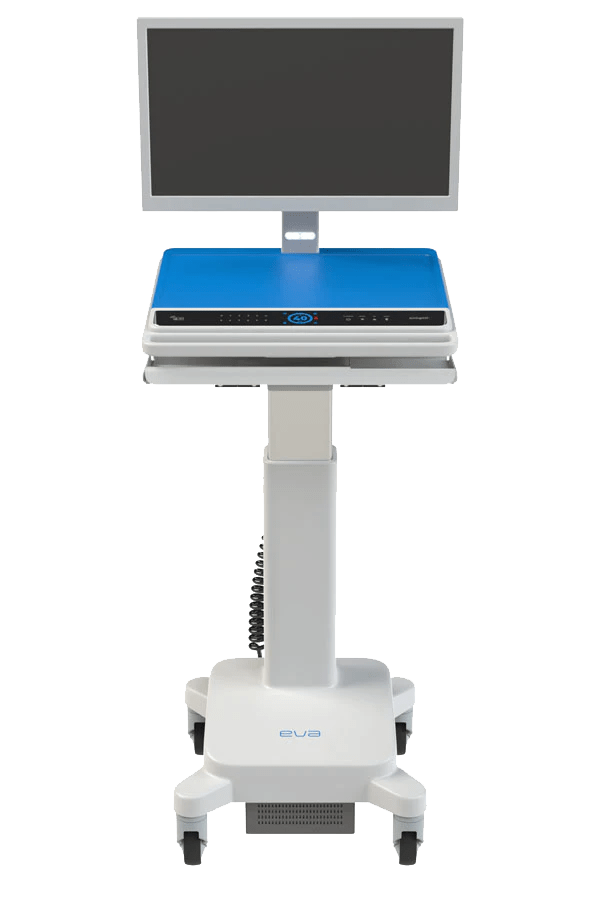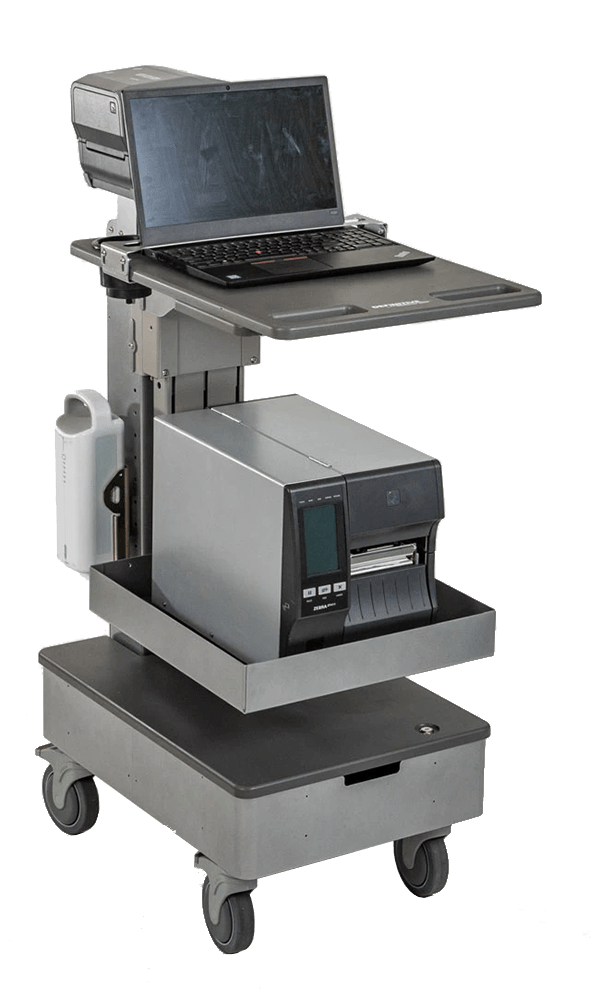Visit Green Cubes at GSE EXPO 2025, Las Vegas, NV September 16-18, 2025, Booth: 3097
Green Cubes Technology was featured in an Electronic Design “Power Management” piece. The full article can be read below, or accessed here.
This article presents the two competing architectures that provide uninterrupted power for medical and industrial mobile workstations: in-base power architectures and swappable battery systems.
Jeffrey VanZwol, Nov 23, 2020
What you’ll learn:
- Which types of medical and industrial devices can be mobilized on workstations with integrated power sources.
- Understand the two types of competing power architectures that are used power mobile workstations—in-base power or swappable battery systems.
- Understand the trends with Li-ion cell chemistry used in medical and industrial workstations.
If you visit a hospital hallway or patient room, you will see many portable medical devices mounted on mobile carts or technology workstations, commonly called Workstations-on-Wheels. These IT devices include laptops, monitors, barcode scanners, and printers. Among other clinical devices are ultrasounds, patient monitors, telepresence, and imaging machines.
A common theme for medical devices integrated onto mobile workstations is a portable power source for uninterrupted power when mobile. Figure 1 shows an example of a leading medical workstation, manufactured by Simplifi Medical. Similarly, if you walk the aisles of a distribution center (DC) for a large retailer, you will see mobile technology carts typically outfitted with IT devices that require uninterrupted power for continuous operation.
Mobile-powered workstations have been used in hospital settings since 2001, when the first mobile workstations were deployed in a Pennsylvania hospital. But prior to 2012, most medical workstations relied on sealed lead-acid (SLA) batteries. Fast forward to 2020, medical and industrial workstations continue to mobilize many devices, and the underlying power architecture has converged around two competing power configurations: in-base power and swappable battery systems.

1. Shown is a medical mobile workstation with in-base power, manufactured by Simplifi Medical.
In-Base Power Architectures
Most mobile workstations offer 120- or 240-V ac power to user devices installed on workstations. An in-base power architecture typically consists of two major subsystems—a 12-V, 40-Ahr (±10), 480-Whr, U1 format Li-ion battery and a 100- to 150-W inverter/charger. The inverter/charger performs several functions, including ac-dc power conversion, battery charging, dc-ac power inversion, an Internet of Things (IoT) processor, a communications transceiver (SMBus, CANBus), and electronics to drive a remote user interface (RUI) or fuel gauge to inform the user about system performance.
Figure 2 provides an interior view of a medical workstation with in-base power subsystems—the battery and inverter/charger. An in-base power architecture has the following characteristics:
- Reliability: This architecture has a permanent hardwired cabling system.
- Nonintrusive operation: This architecture is nonintrusive, and all of the equipment is hidden in the workstation base.
- Larger capacity: Given the physical capacity in most workstation bases, this architecture can accommodate large batteries to support multiple shifts.
- Stationary charging: Once the battery is depleted, this architecture dictates that the workstation be plugged into an ac outlet to recharge the battery, which could take up to three hours. Therefore, the workstation is tethered and stationary while charging.

2. This is an interior view of an in-base power configuration with integrated Li-ion battery and inverter/controller.
Until around 2015, most medical and industrial mobile workstations exclusively used an in-base power architecture. The in-base power components were only available from the OEM and installed in the workstation during manufacturing and assembly.
Swappable Battery Systems
In the last few years, mobile workstation manufacturers have embraced swappable battery systems as a method of powering their workstations. These swappable batteries are the main power source when the workstations are mobile. Quite simply, when a nurse or warehouse employee wishes to use his/her workstation for rounds, they drop a swappable battery into the receiver on the workstation, and the workstation (and the affiliated IT devices) have access to ac and/or dc power throughout the shift.
A swappable battery system typically consists of a 12-V, 20-Ahr, 240-Whr Li-ion battery and a 100- to 150-W inverter/charger. Most workstations are designed to accommodate one or two batteries. Figure 3 shows a swappable battery mounted on a leading industrial workstation, manufactured by Definitive Technology Group.

3. This industrial mobile workstation manufactured by Definitive Technology Group has a swappable battery.
A swappable battery system has more components than an in-base battery architecture. From a block diagram perspective, the system maintains at least three distinct subsystems: the battery, the battery charger, and the battery receiver/controller mounted on the workstation. The battery receiver/controller can perform several functions, including ac-dc power conversion, battery charging, dc-ac power inversion, and contains an IoT processor, Wi-Fi transceiver, a small reserve battery, and electronics to drive a RUI or fuel gauge. A fully integrated controller/receiver will have all of this functionality.
Hot-swapping a battery refers to the removal of a depleted battery and insertion of a charged battery without shutting down the workstation’s electronics and IT devices. This useful feature enables a mobile workstation to supply uninterrupted power, rather than docking a workstation for a battery recharge or shutting down the workstation’s electronics when the batteries are swapped.
Hot-swapping can be achieved with two swappable batteries installed into a common receiver/controller, or by developing a single-bay swappable battery system with a small reserve battery embedded in the receiver/controller. Most modern workstations support hot-swapping, as the alternative is an interruption of power delivery to the workstation, which is disruptive to the user’s devices.
Characteristics of a swappable battery system are:
- 24/7 operation: Workstations can be used 24/7, so the workstation doesn’t experience any downtime to recharge depleted batteries.
- Eliminates need for ac outlets on the floor: An older hospital or warehouse may not have enough distributed ac power outlets on each floor or near the work area to accommodate concurrent charging of workstations. Thus, swappable batteries are charged in a centralized location and then distributed out to the floor.
- Upgrades and retrofits: Non-powered workstations can be upgraded to powered workstations in the field.
- More components: There are three distributed components—battery, battery charger, and receiver/controller—that may make the operator’s workflow more complex.
Swappable battery systems are available from workstation manufacturers, as well as third-party vendors with universal solutions that operate with all workstation brands. In the last five years, almost all workstation manufacturers have introduced swappable battery options to complement or replace their in-base power architecture.
More recently, the swappable battery workflow has been adopted by other industries. Electric motorbike companies (such as Taiwan’s Gogoro) offer subscription-based access to swappable batteries. Electric car manufacturers (such as China’s NIO) offer a “battery as a service” (BaaS) subscription service for their swappable batteries, rather than selling the battery with the vehicle.
Cell Chemistry Options for Workstation Power
All in-base and swappable batteries use lithium-ion rechargeable cells within their battery to store power. The two predominant cell chemistries are lithium iron phosphate (LFP) and lithium nickel manganese cobalt oxide (NMC). For these smaller format batteries, typical cell formats are 18650 (18 mm diameter × 65 mm height), 21700 (21 mm × 70 mm), or 26650 (26 mm × 65 mm) metal-cased cylindrical cells.
NMC cells are typically in an 18650 or 21700 format, operate at a nominal 3.6-3.7 V, provide 2.5-4.0 Ahr of capacity, and can deliver 15-30 A continuous. LFP cells are typically in a 26650 format, operate at a nominal 3.2 V, provide 3.5-4.0 Ahr of capacity, and can deliver 20-50 A continuous. These individual cells are connected in series and parallel to provide the desired voltage, capacity, and current parameters of the battery.
When in-base power and swappable batteries were introduced, OEMs offered either a LFP or NMC version of their products. Over time, the medical workstation market gravitated toward the LFP chemistry for a couple of key reasons:
- Longer cycle life: LFP batteries provide superior cycle life over the life of a mobile workstation. LFP batteries deliver at least 2,000-3,000 full charge/discharge cycles before reaching 80% of original capacity. Typical NMC batteries deliver 500-1,000 full charge/discharge cycles before reaching 80% of original capacity. Assuming that the typical nurse’s shift is eight to 12 hours daily, a single cart could be used continuously across a 24-hour period. This means that the typical battery is fully cycled each day. Industrial workstations experience a similar pattern of usage.
- Intrinsically safer: LFP batteries have an intrinsically safer cathode material than NMC batteries, and they don’t decompose at higher temperatures. This means LFP batteries provide the best thermal and chemical stability, resulting in safety that’s superior to NMC batteries. A LFP battery enters a thermal runaway condition at 250-270°C and releases minimal energy during thermal runaway, compared to a NMC battery. All Li-ion batteries are safe, but LFP is the safest Li-ion battery chemistry available. Given the amount of active battery material in a U1 battery offered with in-base batteries (i.e., 500 Whr), the medical industry opted for the safest Li-ion option.
Currently, despite LFP chemistry having a higher cost per watt-hour than NMC, almost all batteries powering workstations utilize LFP chemistry. LFP Batteries demonstrate superior total cost of ownership over SLA and NMC batteries. The upfront cost is higher, but over the lifetime of the workstation, the total cost is lower.
Conclusion
Whether you’re a medical OEM assessing options to power your next mobile workstation, a hospital assessing alternatives for powering your mobile medical workstation, or a warehouse looking to accelerate the velocity of your operations with mobile IT technology, numerous tried-and-true options exist for in-base power and swappable power solutions. Both options can be integrated into the workstation upon purchase, and swappable batteries can be added as a field upgrade afterward.
The latest trend with medical mobile workstations supports a hybrid configuration, where the workstation accommodates both in-base power and swappable batteries. Although both NMC and LFP batteries are available to power these solutions, the market has selected LFP as the predominate chemistry given the nature of the workstation’s usage—that is, long shifts and continuous use.
Jeffrey VanZwol is Chief Marketing Officer at Green Cubes Technology.
DISCLAIMER Please note that everything posted on this site is up to date at the time of posting. Things change and products may be discontinued at any time. Please contact us for the most up to date information.
